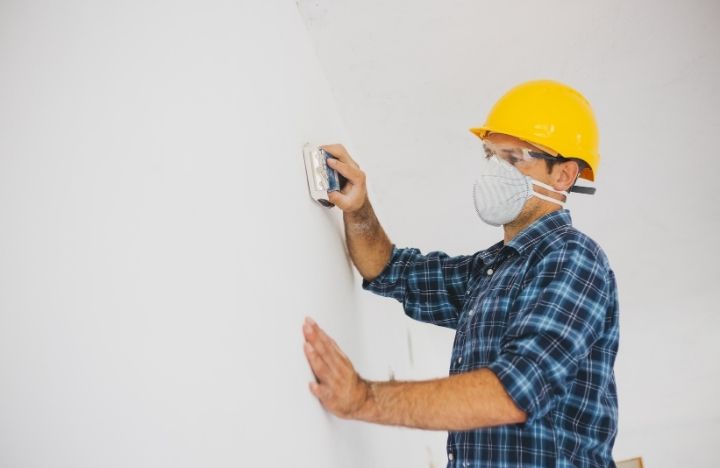Is Breathing in Drywall Dust Toxic?

You have responsibilities for the health and safety of your crews when they are on the job. There are many potential dangers on a residential construction site. Some, like the danger of falls, are obvious and have immediate health impacts. Others, like breathing in the dust that’s created when building materials are cut, sanded, etc., are less obvious and may only affect your workers’ health years down the line. It’s equally important to keep these less obvious dangers in mind, however, and protect your workers from harm and your company from potential financial liability.
What is Drywall Dust?
When drywall is sanded, it releases very fine particles into the air — particles that are about 10 microns in diameter. The human eye cannot see anything smaller than 40 microns in size. To put this in perspective, drywall dust particles are less than half the size of a human white blood cell.
The main ingredient of this dust is gypsum (calcium sulfate dihydrate). Gypsum is a naturally occurring mineral usually found in massive beds that look like sand. One of the most well-known gypsum beds in the United States is White Sands National Monument in New Mexico. The dust can also contain substances like talc, mica and calcite. Drywall has historically included small amounts of silica (silicon dioxide or quartz sand) as well, although in recent years most suppliers have offered silica-free drywall because of the documented long-term health risks of silica exposure.
Effects When Inhaled
The tiny size of drywall dust particles makes it easy for them to float through the air and get into eyes, mouths, noses, and throats, where they can cause short-term irritation in those that inhale drywall dust. Over time, if workers are exposed to this dust without protection, the repeated irritation can cause longer-term allergic symptoms. Drywall dust allergy symptoms include:
- Runny nose
- Coughing
- Sinus congestion/infection
- Sore throat
- Asthma attacks
- Difficulty breathing
- Skin irritation
- Nosebleeds
- Itchy eyes
- Headache
Although gypsum is non-toxic to anyone who hasn’t yet developed a gypsum allergy, other substances found in drywall dust in smaller amounts may not be. Over time, even without allergic symptoms, talc can irritate the respiratory system, damage the lungs and cause cancer. Powdered mica can also lead to long-term respiratory problems.
Silica, also present in concrete, is the most toxic of the potential ingredients in drywall dust. You should check with your suppliers to make sure you are using a silica-free compound. Breathing silica dust over time can cause silicosis — disabling or even fatal lung scarring that damages lung function and is irreversible. Silicosis typically doesn’t occur until after 15-20 years of occupational exposure, but in rare instances it can affect workers after only a few weeks.
How to Get Drywall Dust Out of Lungs
The body has effective mechanisms for ridding itself of unwanted material. The production of mucus, as annoying as it may seem, is part of its process of encapsulating and expelling invaders. Your body will get rid of a certain amount of drywall dust on its own. With the proper precautions and personal protective gear, this process can be enough to keep those exposed in the workplace healthy.
However, it’s dangerous to overwhelm this system. The body’s best defenses take place in the bronchial tubes, before dust actually reaches the lungs. Once it reaches the lungs, the body is less effective in expelling it. If any of these substances damage/scar the lungs, there is no way to reverse it.
Employer Responsibilities and Drywall Dust
As an employer, you are responsible for providing a safe, OSHA-compliant workplace. You should make sure all your drywallers have access to safety training and proper equipment, such as a drywall dust mask, as well as take measures to minimize the level of harmful particulates in the air. Not taking precautions to avoid the known risks of drywall dust leaves you open to legal liability for illnesses and even wrongful death.
Personal Protection
Masks are very effective as front-line protection. N95 face masks should be worn by workers whenever they are sanding drywall. Protective eyewear is also crucial. Workers may want to add gloves or covering clothing to avoid accidentally inhaling dust on their bodies after they leave the site.
Safe Materials
OSHA’s Respirable Crystalline Silica standard for construction requires employers to limit worker exposures to respirable crystalline silica. Check the composition of your drywall boards and joint compounds to ensure they help you meet these standards.
Dust Collection/Clean-Up
Using a high efficiency drywall dust collector/separator to clean up drywall dust in the work area regularly can help minimize workers’ exposure.
Conclusion: Should You Worry About Drywall Dust in the Workplace?
Worry? Perhaps not. But take appropriate precautions? Definitely. Compliance with safety best practices will help protect you, your workers and your business.
Hyphen Solutions’ SupplyPro GM — cloud-based construction software designed to help you manage your drywall projects — includes a safety checklist. You can build safety forms on the mobile platform for workers to fill out on-site to verify that they have completed safety checks. Automated reminders and notifications can ensure everyone knows when safety initiatives are on track.
That’s just one way in which SupplyPro GM can take some of the worry off your plate and make your job easier. Learn more about this automated management solution for residential construction projects today.

